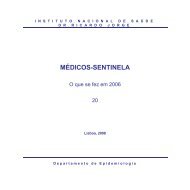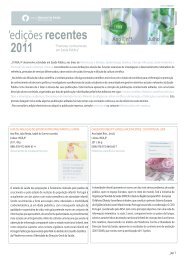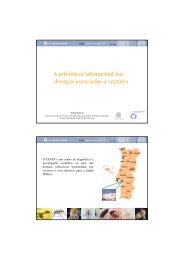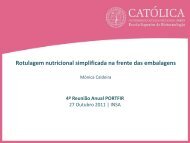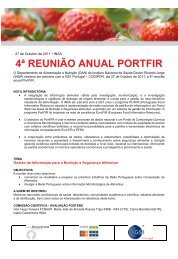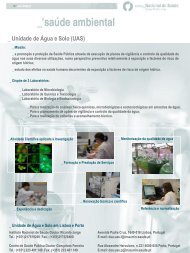European Society of Mycobacteriology - Instituto Nacional de Saúde ...
European Society of Mycobacteriology - Instituto Nacional de Saúde ...
European Society of Mycobacteriology - Instituto Nacional de Saúde ...
Create successful ePaper yourself
Turn your PDF publications into a flip-book with our unique Google optimized e-Paper software.
PP-13<br />
IMPORTANCE OF MOLECULAR TYPING IN SUSPECTED<br />
INTRA-FAMILIAL TRANSMISSION OF TUBERCULOSIS<br />
Obrovac, Mihaela 1 , Katalinic-Jankovic, Vera 1 , Grce, Magdalena 2 , Zmak, Ljiljana 1<br />
1 - Croatian National Institute <strong>of</strong> Public Health<br />
2 - Rudjer Boskovic Institute<br />
Tuberculosis (TB) is most commonly transmitted from a person suffering from infectious pulmonary TB to another person<br />
by infected droplet nuclei. The chance that a person will be infected with TB <strong>de</strong>pends on the intensity, frequency and duration<br />
<strong>of</strong> the exposure to tubercle bacilli. Also, numerous studies emphasize the importance <strong>of</strong> host resistance and hereditary<br />
susceptibility, indicating that the <strong>de</strong>velopment <strong>of</strong> TB is a result <strong>of</strong> a complex interaction between the host and the pathogen<br />
influenced by environmental factors. Assuming that there is prolonged duration and frequency <strong>of</strong> contact between family<br />
members and among household contacts, it is estimated that the risk <strong>of</strong> TB transmission will be high. There are several<br />
studies confirming intra-familial transmission using genotyping <strong>of</strong> isolated M. tuberculosis strains. However, the possibility <strong>of</strong><br />
unsuspected transmission should not be disregar<strong>de</strong>d. We report here <strong>of</strong> two cases <strong>of</strong> suspected TB transmission in families<br />
caused by M. tuberculosis strains that were found not to be i<strong>de</strong>ntical according to genotyping pr<strong>of</strong>iles obtained by <strong>de</strong>termining<br />
variabile number <strong>of</strong> tan<strong>de</strong>m repeats (VNTR) <strong>of</strong> mycobacterial repetitive interspersed units (MIRU). Genotyping was performed<br />
using complete set <strong>of</strong> 24 VNTR loci. Epi<strong>de</strong>miological data were collected by contact tracing and interviewing patients.<br />
Our results show that TB cases in family do not necessarily have to be caused by the same M. tuberculosis strain. Epi<strong>de</strong>miologic<br />
investigations need to be combined with genotyping data for better un<strong>de</strong>rstanding <strong>of</strong> transmission dynamics. Transmission <strong>of</strong><br />
TB cannot be confirmed by contact investigation only, even when intra-familial transmission is suspected.<br />
<strong>European</strong> <strong>Society</strong> <strong>of</strong> <strong>Mycobacteriology</strong> | 30 th Annual Congress | July 2009 | Porto - Portugal<br />
85



